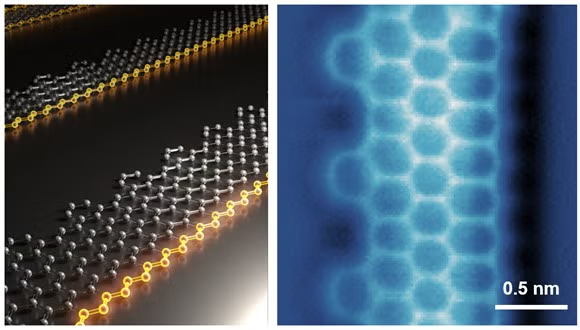
An atomic model of the Janus graphene nanoribbons (left) and its atomic force microscopic image (right).
The research team led by Associate Professor LU Jiong from the NUS Department of Chemistry, in collaboration with international partners have recently achieved a significant breakthrough in the development of next-generation carbon-based quantum materials, opening new horizons for advancements in quantum electronics. The innovation involves a novel type of graphene nanoribbon (GNR), named Janus GNR (JGNR). The material has a unique zigzag edge, with a special ferromagnetic edge state located on one of the edges. This unique design enables the realisation of one-dimensional ferromagnetic spin chain, which could have important applications in quantum electronics and quantum computing.
Assoc Prof Lu said, “Magnetic graphene nanoribbons – narrow strips of graphene formed by fused benzene rings – offers tremendous potential for quantum technologies due to their long spin coherence times and the potential to operate at room temperature. Creating a one-dimensional single zigzag edge in such systems is a daunting yet essential task for realising the bottom-up assembly of multiple spin qubits for quantum technologies.”
The significant achievement is a result of close collaboration among synthetic chemists, materials scientists, and theoretical physicists, including Professor Steven G LOUIE from UC Berkeley in the United States, Professor Hiroshi SAKAGUCHI from Kyoto University in Japan and other contributing authors. The research breakthrough was published in the scientific journal Nature. Read the full article here.
